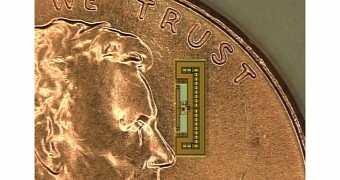We can all agree that ants are tiny things and that it's not that easy to make an electronic device, or part of device, that has the same size. Researchers from Standford have pulled it off though, as amazing as it sounds.
What they've created is a new radio chip that takes up about the same space as three or four of the letters etched on a penny. That's how small it is.
It may sound far-fetched, but it's the truth, as can be seen with a single glance at the photo attached above to the right.
Indeed, several dozen radios can be stacked on top of a single coin, as others have also pointed out. We don't even want to imagine what would happen if someone knocked a stack or two over. Having to look for the ant-sized radios cannot be fun. But we digress.
The traits of the ant-sized radio chip from Stanford
The radio was able to achieve such a small size because the inventors did not include a battery, opting, instead, to have the chip fully dependent on a host source.
Host source which, because the power requirements are so small, can be a nearby radio field. It's pretty much how RFID technology works.
The research team expect their small radio to help create a true Internet of Things at home, and we have to hand it to them that they probably have the right idea.
The whole point of IoT is to connect, via a home network hub or cloud server, everything that runs on electricity. That way, the user would be able to control, say, their washing machine or oven from their TV user interface.
The new radio revealed by Stanford can't send signals over very great distances. Indeed, it won't manage to throw its information across the whole home. However, it could be a nice add-on to a phone or watch, with which you could unlock your door or automatically initiate the preparation of your favorite juice or coffee blend.
Possible uses
As we said, they are many, since the transmitter can be built into anything and can be mass produced for an absurdly low cost. The radio works over 24 GHz and 60 GHz bands by the way.
We can definitely imagine museum exhibits with these chips embedded into the sides of the descriptive banners and lecterns. You would just wave your watch or phone in front of them and get a complete description and history of what you're looking at, beyond what the basic description relays. Same for monuments, statues on the side of park paths, etc.

 14 DAY TRIAL //
14 DAY TRIAL //